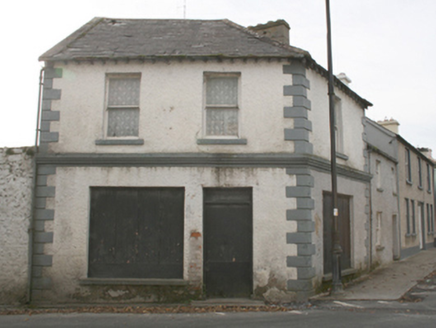Survey Data
Reg No
40801009
Rating
Regional
Categories of Special Interest
Architectural, Historical
Original Use
Public house
Date
1800 - 1840
Coordinates
246998, 450003
Date Recorded
11/10/2008
Date Updated
--/--/--
Description
Corner-sited attached two-bay two-storey house with shop to ground floor, built c. 1820 and altered c. 1900, now disused. Pitched natural slate roof with grey clayware ridge tiles, exposed rafter ends, and with smooth rendered chimneystack to the west gable end. Roughcast rendered walls with smooth rendered block-and-start quoins to the corners, and with moulded stringcourse above ground floor openings. Square-headed window openings with smooth rendered reveals, one-over-one pane horned timber sliding sash windows and stone sills at first floor; enlarged display windows at ground floor level having battened timber panels and stone sills. Square-headed door opening to the north end of the east elevation having smooth rendered reveal, battened timber battened, and plain overlight. Fronts directly onto street on the south-east corner of Malin village green, garden to south fronting onto the north bank of the estuary of the Ballyboe River.
Appraisal
This simple house and former public house, of probable early nineteenth-century date, retains its original form and character despite being no longer in use. It is one of the few buildings located around the village green to the centre of Malin that still retains much of its original fabric, including sash windows and natural slate roof, which adds to its integrity. Located at a focal point at the main entrance into the village from the south, this building was formerly in use as a public house. The simple render detailing including moulded stringcourse and block-and-start quoins adds an element of decorative interest to this otherwise unassuming building. This render detailing is a later addition, perhaps added c. 1900. According to local tradition the minutes of one of the Daniel O'Connell's (1775-1847) famous ‘monster meetings’, which apparently took place on a local hillside during the first decades of the nineteenth century, were formerly keep at this house\building, adding an element of historic interest to this site. This building is of a type that was, until recent times, a ubiquitous feature of the streetscapes of small Irish towns and villages. However, buildings of this type are now fast disappearing due to insensitive alteration and demolition, making this building at Malin an increasingly rare relatively intact example of its type. Sensitively restored, this building would represent an integral element of the built heritage of Malin.









